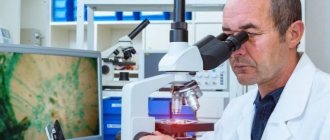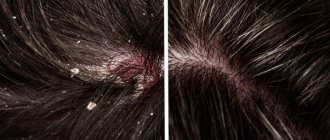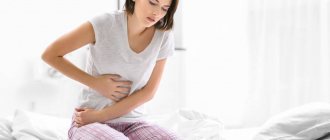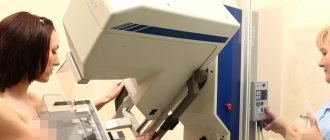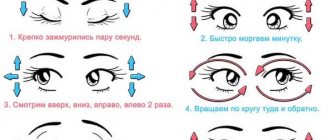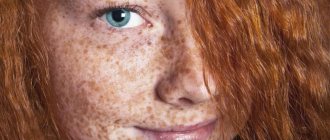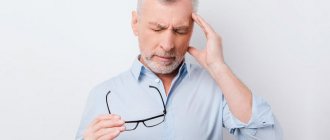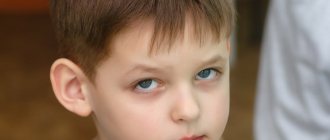Author:
Kuzmina Tatyana Sergeevna dermatologist, Ph.D.
Quick transition Treatment of seborrheic dermatitis
In mild cases in children, treatment can be carried out by a pediatrician who, if necessary, will refer to a specialist.
Seborrheic dermatitis is also known as seborrheic eczema, seborrhea.
Seborrheic dermatitis is a common chronic skin disease that affects areas rich in sebaceous glands: the head, face, and torso.
Seborrheic dermatitis on the face photo
Photo 1. Seborrheic dermatitis on the face of an adult
Photo 2. Seborrheic dermatitis on the face of an adult
Photo 3. Seborrheic dermatitis
Photo 4. Seborrheic dermatitis on a child’s face
Types of seborrhea of the scalp with developed seborrheic dermatitis
Seborrhea on the head has three types:
1) Dry seborrhea.
Accompanied by abundant dandruff, the scalp becomes irritated and very sensitive, hair becomes dry and brittle, and hair loss often begins. Visually, it seems that the scalp does not produce enough oil and many people mistakenly believe that they simply have dry skin, although in fact it is a variant of seborrheic dermatitis.
2) Oily seborrhea.
It often occurs during adolescence, during a period of hormonal imbalance in the body, but can occur at any age. Depending on the composition of sebum, oily seborrhea can be liquid or thick.
- liquid seborrhea is characterized by severe itching and hair loss. Hair acquires an unhealthy shine and becomes greasy very quickly.
- thick seborrhea. A characteristic symptom is thick, oily dandruff, which can tightly clog the sebaceous ducts and thereby provoke inflammation. If complications occur, suppuration may occur at the site of inflammation.
3) Mixed seborrhea.
It is a manifestation of dry seborrhea on the head and oily seborrhea on the face.
Causes of seborrheic dermatitis on the face
The main cause of seborrheic dermatitis is the increased functioning of the sebaceous glands and a change in the composition of the fat they produce. A similar situation develops when the Malassezia fungus multiplies excessively (normally it is part of the skin microflora). In this case, it penetrates the sebaceous glands and produces a special secretion that forces subcutaneous fat to break down, forming fatty acids that irritate the skin and contribute to the occurrence of rashes.
Dermatitis affects men more often than women, which is explained by the action of androgen, a male hormone. This hormone stimulates the synthesis of subcutaneous sebum. In women, the disease usually manifests itself when estrogen levels decrease and androgen concentrations increase.
Seborrheic dermatitis on the forehead is especially often diagnosed in people whose close relatives have a similar problem, which is associated with a hereditary predisposition.
Other factors can also provoke the development of the disease:
- hormonal imbalances;
- disruption of the endocrine system (especially the thyroid gland);
- weakened immunity;
- hypovitaminosis;
- unfavorable environmental situation;
- improper facial skin care;
- excessive sweating;
- poor nutrition;
- lack of sleep;
- uncontrolled use of medications, especially hormonal ones;
- exacerbation of chronic diseases;
- presence of infection in the body;
- dysfunction of the nervous system, manifested in the form of epilepsy or schizophrenia;
- diabetes;
- pathologies of the gastrointestinal tract;
- frequent stressful situations;
- overwork;
- malignant tumors in the adrenal glands or genitals.
Head and hair care products as a treatment for dermatitis
Skin care products for the scalp, body, and hair for seborrhea should solve the following problems:
- relieve itching and soothe the scalp;
- suppress the growth of fungal flora on the head;
- provide a gentle, gentle cleansing of the scalp.
In some cases, treatment is supplemented with oral agents - antifungal drugs and others. Treatment using topical corticosteroids is also possible, but this treatment is used for a short time and only as prescribed by a doctor.
Symptoms of seborrheic dermatitis on the face
With seborrheic dermatitis on the face, symptoms appear:
- the appearance of pink, red or burgundy spots on the skin;
- the formation of white or yellowish scales and hemorrhagic crusts;
- peeling of the skin;
- irritation and increased sensitivity of the skin;
- itching and burning of varying intensity.
The course of the disease worsens in the autumn. In summer, unpleasant symptoms usually disappear.
If the ducts of the sebaceous glands become clogged, acne appears.
The disease is especially severe in men who grow beards and mustaches. Large plaques form under the hairline, which eventually transform into papules. If an infection occurs, then erythroderma is also detected. When papules coalesce, swollen areas colored red form.
The symptoms of seborrheic dermatitis are similar to those of other dermatological diseases. Therefore, only a doctor can make a correct diagnosis after a thorough examination of the patient.
Symptoms
Seborrheic dermatitis is manifested by redness, peeling with “oily” scales with a certain localization of foci.
In children - isolated on the scalp (in the frontal area it is called the “baby cap” or “milk crust”), behind the ears and in the external auditory canal, on the face (in the area of the eyebrows, wings of the nose), on the back of the neck (along the edge of hair growth), in areas of skin friction (in folds), under diapers.
Sometimes seborrheic dermatitis in children is widespread. These are rashes in the form of spots with greasy crusts, merging into larger areas. In some cases it is accompanied by itching.
In adults, seborrheic dermatitis is presented in the scalp area, on the face: in the area of the eyebrows, behind the ears, inside the ears, on the wings of the nose and in the areas of the cheeks adjacent to the nose.
It can manifest itself as separate spots with peeling, total damage to the scalp, damage to the eyelids in the form of blepharitis, damage to the chest wall in the form of individual nodules and spots with crusts on the surface, inflammation of the hair follicles on the skin of the upper half of the body (ostiofolliculitis).
How to treat seborrheic dermatitis on the face?
If symptoms of seborrheic dermatitis appear on the face, treatment should be carried out by a specialist. Self-medication can only worsen the condition.
The dermatologist will examine the patient’s skin and refer it for laboratory testing. If necessary, he will advise you to consult a neurologist, endocrinologist, gastroenterologist, andrologist or gynecologist. Based on the diagnostic results, the doctor will select the optimal treatment, which should be comprehensive. First, the dermatologist prescribes weak drugs. If they do not produce the desired result, then he moves on to potent ones.
To effectively cope with the disease, it is imperative to identify and eliminate the cause of the disease. If dermatological problems are caused by disturbances in the digestive system, the patient is referred to a gastroenterologist. After the examination, he will prescribe suitable medications, most often enzymes, sorbents and choleretic agents. Enzymes and choleretic drugs will restore the functioning of the gastrointestinal tract, and sorbents will remove toxic substances from the body.
Typically, treatment for nasal dermatitis includes:
- compliance with the diet prescribed by a specialist;
- drug therapy;
- physiotherapy;
- maintaining personal hygiene using gentle products.
Drug therapy involves taking:
- antihistamines - relieve itching;
- probiotics – restore intestinal microflora and normalize the functioning of the digestive tract;
- vitamin complexes – strengthen the immune system and increase the body’s resistance.
In addition to medications intended for oral use, external agents that have a moisturizing, anti-inflammatory and antifungal effect are recommended.
Both glucocorticosteroid hormonal ointments and non-hormonal drugs can be used. But you need to know that glucocorticosteroids, although they have an effective effect (relieve inflammation, swelling and redness), but they are addictive and, with prolonged use, provoke side effects (vasodilatation, the formation of rosacea and telangiectasia, the development of erythema).
Therefore, it is better to give preference to non-hormonal drugs, among which the products of the “Losterin” series (cream, ointment, gel, shampoo) have shown particular effectiveness. They are characterized by a neutral composition, do not contain hormones, do not irritate the skin and are not addictive. The drugs included in the “Losterin” line can be used not only by adults, but also by newborn babies. They are recommended for daily use both during remission and during acute inflammation. Active substances (naphthalan, salicylic acid, natural oils, medicinal plant extracts) are included in the composition of “Losterin” products in optimal proportions, which determines the most effective therapeutic effect. Even if seborrheic dermatitis has passed, Losterin should continue to be used to prevent a relapse.
Physiotherapeutic procedures can effectively complement drug treatment. Small doses of ultraviolet light will ease the course of the disease, restore the functioning of the sebaceous glands, and relieve redness, swelling and itching.
Dry seborrhea: diagnosis, symptoms, causes, treatment methods
Dry seborrhea: diagnosis, symptoms, causes, treatment methods
Dry seborrhea (not to be confused with mixed and oily) is a separate type of skin disease that develops as a result of weak activity of the sebaceous glands. Services Expert Clinics Mesotherapy for hair A relatively new technique has already become a favorite among both doctors and patients due to its low trauma and good results. Mesotherapy for hair Treatment of hypothyroidism Treatment and prevention of hypothyroidism are extremely important for maintaining and promoting health. Treatment of hypothyroidism Plasma therapy for hair This is one of the innovative methods that allows you to naturally restore hair and improve its quality. Plasma therapy for hair Call me back What is seborrhea? Seborrhea is a chronic inflammatory skin disease that is caused by dysfunction of the sebaceous glands responsible for the formation of sebum. It mainly affects the scalp, causing scaly patches and persistent dandruff. It can also spread to areas of the body such as the face, nose, eyebrows, ears, eyelids, chest and genitals. The course of seborrhea is characterized by frequent relapses and remissions. In people with this disease, the secretion of fat is disrupted, and as a result, the chemical composition of sebum changes, and its bactericidal properties are suppressed. This pathology most often occurs due to hormonal imbalance in both adults and adolescents. Symptoms of dry seborrhea and the difference from oily seborrhea. The clinical picture varies depending on the form of the disease. The classic course of the disease is characterized first by the appearance of dry seborrhea, then oily seborrhea in the back of the head. Signs of dry seborrhea: Dry, tight skin, sometimes covered with small cracks; Itching of the affected areas, especially after washing; Small, dry, copious dandruff that looks like flakes; Thin, brittle and dull hair with split ends; Reddish spots on the affected areas of the skin; Thinning hair; Hair loss (characterized by severe form). Signs of oily seborrhea: Oily and thick skin; Large blackheads and pores; Acne; Itching; Film in the form of glued flakes of white and yellow colors of different sizes; Greasy hair; Thick or thin sebum on the surface of seborrheic areas; Inflammation of the sebaceous glands and skin; Hair loss (with a long course of the disease). Mixed seborrhea Symptoms of dry and oily seborrhea sometimes appear simultaneously: the scalp becomes dry, flaky, the hair is thin and brittle, and the skin of the face, neck, upper back and chest is very oily, shiny with elements of inflammation. Causes of dry seborrhea In the course of numerous clinical studies, it has been established that the yeast-like fungi Pityrosporum ovale, which are permanent inhabitants of healthy human skin, play a major role in the development of seborrhea of the scalp and the appearance of dandruff. Throughout our lives, these microorganisms parasitize human skin, feeding on the secretions of the sebaceous glands. However, under unfavorable conditions for the body, the protective function of the skin is disrupted and, as a result, it loses control over the growth of microflora. The natural barrier no longer works. Normally, a healthy person has about 30-50% of these fungi on the scalp. If a patient has dandruff, about 75% of them are detected, and in the most severe cases - about 90%. There are a number of causes of seborrhea that cause destructive changes in the body: Impaired metabolic processes; Hormonal changes of a physiological type (menopause, puberty), as well as pathological changes expressed by dysfunction of the hormonal system; Emotional overload caused by stress and depression; Hereditary factor: often a genetic predisposition contributes to the onset of the disease; Disturbances in the functioning of the body's immune system; Excessive use of care products or, conversely, poor hygiene; Using aggressive and inappropriate care products, as well as using products containing alcohol on a regular basis; Cosmetic procedures with a high risk of side effects; Excessive exposure to sunlight Poor nutrition, manifested in excessive consumption of fatty meats, spicy foods, sugar and honey. This disease can be caused by natural causes of seborrhea. The latter is manifested by hormonal changes in the body (pregnancy, menopause, etc.). Seborrhea of this form is called physiological, because after completion of a certain process, the hormones are normalized and the disease goes away on its own. When taking hormonal drugs such as anabolic steroids or birth control pills, symptoms of seborrhea may appear on the scalp, face and other parts of the body. Seborrhea can be caused by pathologies of the endocrine system, such as diabetes, dysfunction of the sweat glands and others. People with HIV have an 80% risk of contracting the disease. Seborrhea of the scalp can also occur in patients with paralysis, schizophrenia, epilepsy and Parkinson's disease. If this is the case, talk to your doctor to learn about different seborrhea treatment options for your case. Diagnosis Diagnosis of oily seborrhea is carried out approximately as follows: Collecting an anamnesis from the attending physician; Identification of possible risk factors for the manifestation of the disease; Donating blood for biochemical analysis; Donating blood for hormones; Study of the general condition of hair and dermis; Ultrasound of the thyroid gland, peritoneal organs (in some cases). If you suspect a dry form of seborrhea, you should consult the following doctors: Endocrinologist; Dermatologist; Neurologist; Gynecologist. Treatment of dry seborrhea To get rid of dry seborrhea, it is necessary to carry out complex treatment, which consists of several stages. To treat dry forms of seborrhea, doctors use the following methods: Hormonal therapy. It is used mainly in the development of severe forms of the disease. The use of drugs, namely the following groups: Sulfur-based drugs; Zinc-based preparations; Antifungal; Antibacterial; Anti-inflammatory drugs. Particularly effective in the treatment of dry seborrhea is sulfur ointment (10%), which must be rubbed into the skin for eight days. The use of vitamins D, E, A, B. Dry seborrhea is often associated with their deficiency. Increasing immunity (treatment of all identified diseases of the body). The use of procedures of different effects (mesotherapy, massage, herbal medicine, cryotherapy, ultraviolet irradiation, ozone therapy). They should be prescribed exclusively by the attending physician. Diet. To get rid of this unpleasant illness, you will have to adjust your diet and enrich it with the following products: Curdled milk; Fruits; Eggs; Oatmeal; Vegetables. You should also limit your consumption of the following categories: Fatty foods; Animal fats; Spices; Pickles; Spicy dishes; Canned food. You can also try folk remedies. Home methods for combating seborrhea Home treatment methods are aimed at replenishing the lack of sebum. Most often, rubbing oils and oil-based creams are used for this. IMPORTANT: Medicines must be rubbed in with light movements. Intense rubbing causes hair to break and be pulled out. Rub the oils or cream in with gentle, thorough movements for 15 minutes. You need very little oil for rubbing. Its excess accelerates hair contamination, disrupts skin thermoregulation and complicates the process of sweating. For medicinal purposes, oil extracts of the following medicinal plants are used for dry seborrhea: Parsley; Burdock; Violet tricolor; Flax seed; Black poplar; Sea buckthorn. Let's highlight other most effective components for home use: Aloe vera. This medicinal plant has strong antibacterial properties. Its juice is included in many cosmetic and medicinal products. Numerous clinical studies have proven the effectiveness of this plant, especially for the treatment of seborrhea of the scalp and other parts of the body. 62% of patients participating in medical studies felt significant relief and noted a decrease in the severity of symptoms of seborrheic disease. Tea tree essential oil. This is an excellent antiviral, antifungal and antiseptic agent. That is why it is actively used to treat seborrhea. The oil itself is very concentrated in its pure form, so it is added to creams, shampoos and lotions. Dead Sea salt. A product known for its antiseptic properties and very useful in the treatment of seborrhea. A popular treatment procedure is a salt bath. Apple vinegar. It is used to rinse hair and helps control pathogenic microflora in the form of bacteria and fungi, which reduces the risk of occurrence or development of disease. Mustard mask. Useful for normalizing the condition of the scalp, helping to reduce hair loss and improve its structure. Be careful when applying mustard masks without adding honey or sugar and reduce the duration of the procedure from 10 to 15 minutes. Honey. Because it has antibacterial properties, honey is used in topical external treatments. Ultraviolet radiation. In the correct dosage, it is also used to treat dry seborrhea. It is known that sun rays help fight pathogenic microflora, which helps reduce symptoms. The following natural remedies have also proven themselves to be effective: Gruel made from crushed hazelnut kernels; Oil infusion from medicinal marshmallow seeds; Oil infusion prepared from black poplar buds; Burr oil; Sea buckthorn + olive oil; Vegetable oil + lemon juice. For dry seborrhea, it is recommended to wash the head with herbal infusions from onion peels, coltsfoot, and oregano. The main thing is that the patient does not have an allergic reaction to this or that medicinal plant. Prevention The essence of prevention is proper skin and hair care. If the skin is problematic, you need to monitor, care for, and then use special cosmetics (for dry skin). It is also advisable to take mineral complexes and multivitamins as a preventive measure. To avoid the development of dry seborrhea, you must follow simple rules: Avoid stressful situations. Spend more time outdoors. Wash your hair, taking into account the degree of contamination. Strengthen your immune system. Eat right. The most unpleasant consequences of the development of the dry form of seborrhea is premature hair loss, which provokes the occurrence of alopecia. With timely detection of the disease, as well as its comprehensive treatment, it is possible to overcome the disease in a short time with minimal costs. Sign up
2021-12-08
2021-12-09
Expert Clinics
Expert Clinics
Dry seborrhea: diagnosis, symptoms, causes, treatment methods
Dry seborrhea: diagnosis, symptoms, causes, treatment methods
Dry seborrhea: diagnosis, symptoms, causes, treatment methods
Prevention of seborrheic dermatitis on the face
To prevent dermatitis on the forehead from causing a relapse, it is recommended to follow several rules:
- strengthen the immune system;
- cleanse the body of waste and toxins;
- exclude from the diet salty and spicy foods, fatty and smoked foods, marinades, spices and condiments, sweets, chips and crackers, products containing preservatives, flavor enhancers and dyes;
- introduce fermented milk products into the menu, which include lacto- and bifidobacteria, animal proteins, bran, buckwheat, oatmeal;
- cook food with vegetable oil;
- restore the functioning of the digestive system.
Diagnosis of dermatitis
In the An-Tek Laboratory, before treatment of skin dermatitis, the patient undergoes diagnostics. A trichologist will evaluate the condition of the skin on the head, the features of its scalp, and use a trichoscope to study the structure of the hair, its thickness and other characteristics. With seborrhea, a clinical picture is enough to make a diagnosis: when prescribing treatment, the doctor will make sure that the patient really has seborrhea, and not other diseases with similar symptoms - rosacea, lichen, psoriasis, eczema and others.
The first recommendation to the patient is to use a special shampoo for the head, indicated for the treatment of seborrhea and dermatitis. However, this remedy alone may not be enough to return the skin to its normal state. In this case, the doctor will resort to active general treatment. Seborrhea responds well to the use of local remedies, but an integrated approach is always more effective.
